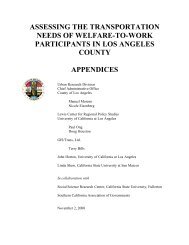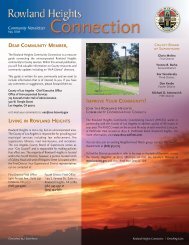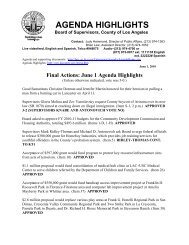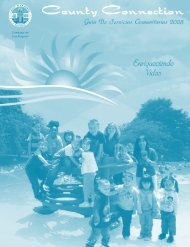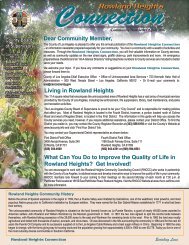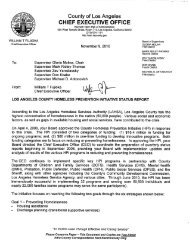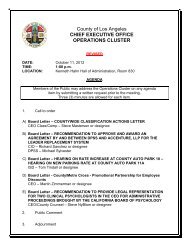Layout 1 (Page 1) - Chief Executive Office - Los Angeles County
Layout 1 (Page 1) - Chief Executive Office - Los Angeles County
Layout 1 (Page 1) - Chief Executive Office - Los Angeles County
Create successful ePaper yourself
Turn your PDF publications into a flip-book with our unique Google optimized e-Paper software.
LIVING IN THE ANTELOPE VALLEY<br />
STORIES FROM THE ANTELOPE VALLEY<br />
On May 1, 1914, the Llano del Rio, a utopian<br />
community, was established in the southeast<br />
Antelope Valley near the present day community of<br />
Llano. Among its founders was Indiana native Job Harriman, an idealist<br />
and charismatic young lawyer who<br />
had unsuccessfully run for Vice<br />
President in 1900 on the first-ever<br />
Socialist Party platform and for<br />
mayor of <strong>Los</strong> <strong>Angeles</strong> in 1911.<br />
Thwarted by political efforts to<br />
effect social change, Harriman<br />
and his fellow visionaries instead<br />
thought they could accomplish<br />
their socialist utopian goals via the<br />
colony’s cooperative economic system.<br />
Designed by prominent feminist and architect, Alice Constance Austin,<br />
Llano del Rio thrived for several years on its egalitarian lifestyle, including<br />
dairy farming, orchard cultivation, and preparing publications, and its<br />
population exceeded 1,000 at one point.<br />
However, its undoing began when it was discovered that an earthquake<br />
fault line diverted much of its long-term water supply and Harriman and<br />
company were unsuccessful at getting area land barons to sell access to<br />
a new supply. After additional internal hurdles, in 1917, about 200<br />
participants moved the colony to Stables, Louisiana, a defunct lumber<br />
town, and renamed it New Llano.<br />
Group of Llano del Rio Colonists, Christmas, 1914<br />
For many more stories and photographs depicting the history of the<br />
Antelope Valley, please visit the <strong>County</strong> of LA Public Library’s<br />
Antelope Valley Community History website at<br />
www.colapublib.org/history/antelopevalley.<br />
2 | ANTELOPE VALLEY CONNECTION | Enriching Lives<br />
Ruins of the Llano del Rio community can still be<br />
found today along Pearblossom Highway<br />
(Highway 138) near 165th Street East, a few<br />
miles east of Pearblossom.<br />
Despite their relatively brief existence, the<br />
Llano colonies made a mark as a social<br />
experiment, including having one of the<br />
country’s first Montessori schools, widespread<br />
recognition for the production and sale of<br />
high-quality food and other items, hosting<br />
a fertile intellectual and cultural climate,<br />
replete with orchestras and theater groups,<br />
and innovative social services, including<br />
low-cost housing, minimum-wage pay, and<br />
universal health care, which were decades<br />
ahead of their time. Though financial woes<br />
and infighting forced the colony into bankruptcy<br />
in 1939, Llano del Rio is today considered<br />
Western American history’s most important<br />
non-religious utopian community.<br />
Dormitory and Hotel Llano, 1916



